Blog & Latest Updates
Fly Fishing Articles
Insects by Common Name


Insect Order Trichoptera (Caddisflies)
Taxonomic Navigation -?-
Kingdom
Animalia (Animals)
» Phylum
Arthropoda (Arthropods)
» Class
Insecta (Insects)
» Order Trichoptera (Caddisflies)
5 families aren't included.
Common Name
| Match | Common Name |
| Caddisflies |
This is page 10 of specimens of Trichoptera. Visit the main Trichoptera page for:
- The behavior and habitat of Trichoptera.
- 55 underwater pictures of Trichoptera.
Pictures of 129 Caddisfly Specimens:
Dolophilodes (Medium Evening Sedges) Caddisfly Larva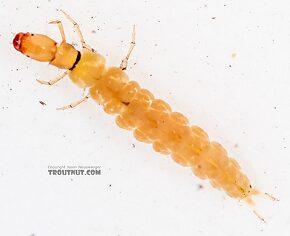 View 9 PicturesI think this larva best fits Dolophilodes, in which the anterior (Anterior: Toward the front of an organism's body. The phrase "anterior to" means "in front of.") margin of the frontoclypeus is supposed to be "slightly asymmetrical." I can't confidently make out the asymmetry, but the other genera are supposed to have either greater asymmetry or a symmetrical, but convex, shape, whereas this one is clearly concave.
View 9 PicturesI think this larva best fits Dolophilodes, in which the anterior (Anterior: Toward the front of an organism's body. The phrase "anterior to" means "in front of.") margin of the frontoclypeus is supposed to be "slightly asymmetrical." I can't confidently make out the asymmetry, but the other genera are supposed to have either greater asymmetry or a symmetrical, but convex, shape, whereas this one is clearly concave.
Based on distribution records, the species should be either aequalis, dorcus, or pallidipes, but I can't find any source to distinguish between them.
 View 9 PicturesI think this larva best fits Dolophilodes, in which the anterior (Anterior: Toward the front of an organism's body. The phrase "anterior to" means "in front of.") margin of the frontoclypeus is supposed to be "slightly asymmetrical." I can't confidently make out the asymmetry, but the other genera are supposed to have either greater asymmetry or a symmetrical, but convex, shape, whereas this one is clearly concave.
View 9 PicturesI think this larva best fits Dolophilodes, in which the anterior (Anterior: Toward the front of an organism's body. The phrase "anterior to" means "in front of.") margin of the frontoclypeus is supposed to be "slightly asymmetrical." I can't confidently make out the asymmetry, but the other genera are supposed to have either greater asymmetry or a symmetrical, but convex, shape, whereas this one is clearly concave. Based on distribution records, the species should be either aequalis, dorcus, or pallidipes, but I can't find any source to distinguish between them.
Collected August 3, 2020 from the East Fork Big Lost River in Idaho
Added to Troutnut.com by Troutnut on August 19, 2020
Added to Troutnut.com by Troutnut on August 19, 2020
Male Glossosoma alascense Saddle-case Maker Adult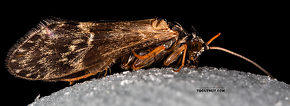 View 8 PicturesI lost track of this specimen before I could get it under my microscope, but caddis expert Dave Ruiter was able to identify it from pictures as Glossosoma, with an uncertain suggestion of G. alascense as the most likely species.
View 8 PicturesI lost track of this specimen before I could get it under my microscope, but caddis expert Dave Ruiter was able to identify it from pictures as Glossosoma, with an uncertain suggestion of G. alascense as the most likely species.
 View 8 PicturesI lost track of this specimen before I could get it under my microscope, but caddis expert Dave Ruiter was able to identify it from pictures as Glossosoma, with an uncertain suggestion of G. alascense as the most likely species.
View 8 PicturesI lost track of this specimen before I could get it under my microscope, but caddis expert Dave Ruiter was able to identify it from pictures as Glossosoma, with an uncertain suggestion of G. alascense as the most likely species.Brachycentrus americanus (American Grannom) Caddisfly Larva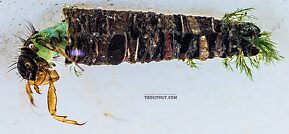 View 18 PicturesThis species of Brachycentrus was extremely common in mid-September kick net samples in the Yakima canyon.
View 18 PicturesThis species of Brachycentrus was extremely common in mid-September kick net samples in the Yakima canyon.
 View 18 PicturesThis species of Brachycentrus was extremely common in mid-September kick net samples in the Yakima canyon.
View 18 PicturesThis species of Brachycentrus was extremely common in mid-September kick net samples in the Yakima canyon.Collected September 12, 2020 from the Yakima River in Washington
Added to Troutnut.com by Troutnut on September 19, 2020
Added to Troutnut.com by Troutnut on September 19, 2020
Rhyacophila (Green Sedges) Caddisfly Larva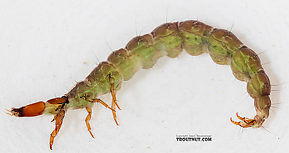 View 7 PicturesDave Ruiter identified this specimen as part of the Rhyacophila betteni group, but with over 20 species it's difficult to narrow down beyond that.
View 7 PicturesDave Ruiter identified this specimen as part of the Rhyacophila betteni group, but with over 20 species it's difficult to narrow down beyond that.
 View 7 PicturesDave Ruiter identified this specimen as part of the Rhyacophila betteni group, but with over 20 species it's difficult to narrow down beyond that.
View 7 PicturesDave Ruiter identified this specimen as part of the Rhyacophila betteni group, but with over 20 species it's difficult to narrow down beyond that.Collected July 25, 2019 from Mystery Creek #249 in Washington
Added to Troutnut.com by Troutnut on July 26, 2019
Added to Troutnut.com by Troutnut on July 26, 2019
Male Leptoceridae Caddisfly Adult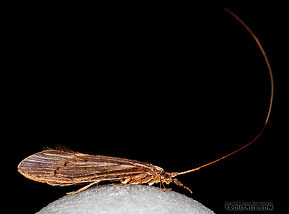 View 12 Pictures
View 12 Pictures
 View 12 Pictures
View 12 PicturesCollected June 29, 2019 from the Madison River in Montana
Added to Troutnut.com by Troutnut on July 17, 2019
Added to Troutnut.com by Troutnut on July 17, 2019
Male Lepidostoma (Little Brown Sedges) Little Brown Sedge Adult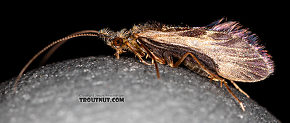 View 7 PicturesOn an evening filled with millions of caddisflies, this one stood out as the only one of its kind that found its way into my net. Dave Ruiter identified it from the photos as a Lepidostoma specimen in the pluviale species group.
View 7 PicturesOn an evening filled with millions of caddisflies, this one stood out as the only one of its kind that found its way into my net. Dave Ruiter identified it from the photos as a Lepidostoma specimen in the pluviale species group.
 View 7 PicturesOn an evening filled with millions of caddisflies, this one stood out as the only one of its kind that found its way into my net. Dave Ruiter identified it from the photos as a Lepidostoma specimen in the pluviale species group.
View 7 PicturesOn an evening filled with millions of caddisflies, this one stood out as the only one of its kind that found its way into my net. Dave Ruiter identified it from the photos as a Lepidostoma specimen in the pluviale species group.Collected July 1, 2019 from the Madison River in Montana
Added to Troutnut.com by Troutnut on July 18, 2019
Added to Troutnut.com by Troutnut on July 18, 2019
Male Hydropsyche occidentalis (Spotted Sedge) Caddisfly Adult View 6 PicturesDave Ruiter identified this specimen from pictures as Hydropsyche occidentalis.
View 6 PicturesDave Ruiter identified this specimen from pictures as Hydropsyche occidentalis.
 View 6 PicturesDave Ruiter identified this specimen from pictures as Hydropsyche occidentalis.
View 6 PicturesDave Ruiter identified this specimen from pictures as Hydropsyche occidentalis.Collected June 30, 2019 from the Madison River in Montana
Added to Troutnut.com by Troutnut on July 17, 2019
Added to Troutnut.com by Troutnut on July 17, 2019
Female Grammotaulius lorettae (Northern Caddisfly) Caddisfly Adult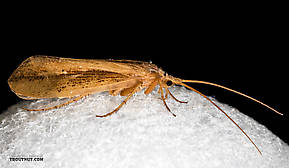 View 8 Pictures
View 8 Pictures
 View 8 Pictures
View 8 PicturesCollected August 11, 2018 from the Henry's Fork of the Snake River in Idaho
Added to Troutnut.com by Troutnut on June 12, 2019
Added to Troutnut.com by Troutnut on June 12, 2019
Male Onocosmoecus unicolor (Great Late-Summer Sedge) Caddisfly Adult View 15 PicturesI first just assumed this was Dicosmoecus based on anglers' conventional wisdom since it's a large orange "October caddis," but Creno set me straight. I should have keyed it out. After another look under the microscope, it lacks an anepisternal wart on the mesopleuron (Mesopleuron: The side of the insect mesothorax, and the part to which the fore wings are attached in mayflies.), which rules out Dicosmoecus. The midtibiae have 2 apical (Apical: Close to the apex; tip or end.) spurs and 1 pre-apical (Apical: Close to the apex; tip or end.) spur, and from there the color pattern of the wing points to Onocosmoecus. The location then narrows the species to unicolor.
View 15 PicturesI first just assumed this was Dicosmoecus based on anglers' conventional wisdom since it's a large orange "October caddis," but Creno set me straight. I should have keyed it out. After another look under the microscope, it lacks an anepisternal wart on the mesopleuron (Mesopleuron: The side of the insect mesothorax, and the part to which the fore wings are attached in mayflies.), which rules out Dicosmoecus. The midtibiae have 2 apical (Apical: Close to the apex; tip or end.) spurs and 1 pre-apical (Apical: Close to the apex; tip or end.) spur, and from there the color pattern of the wing points to Onocosmoecus. The location then narrows the species to unicolor.
 View 15 PicturesI first just assumed this was Dicosmoecus based on anglers' conventional wisdom since it's a large orange "October caddis," but Creno set me straight. I should have keyed it out. After another look under the microscope, it lacks an anepisternal wart on the mesopleuron (Mesopleuron: The side of the insect mesothorax, and the part to which the fore wings are attached in mayflies.), which rules out Dicosmoecus. The midtibiae have 2 apical (Apical: Close to the apex; tip or end.) spurs and 1 pre-apical (Apical: Close to the apex; tip or end.) spur, and from there the color pattern of the wing points to Onocosmoecus. The location then narrows the species to unicolor.
View 15 PicturesI first just assumed this was Dicosmoecus based on anglers' conventional wisdom since it's a large orange "October caddis," but Creno set me straight. I should have keyed it out. After another look under the microscope, it lacks an anepisternal wart on the mesopleuron (Mesopleuron: The side of the insect mesothorax, and the part to which the fore wings are attached in mayflies.), which rules out Dicosmoecus. The midtibiae have 2 apical (Apical: Close to the apex; tip or end.) spurs and 1 pre-apical (Apical: Close to the apex; tip or end.) spur, and from there the color pattern of the wing points to Onocosmoecus. The location then narrows the species to unicolor.Collected September 17, 2020 from the Yakima River in Washington
Added to Troutnut.com by Troutnut on September 19, 2020
Added to Troutnut.com by Troutnut on September 19, 2020
Rhyacophila mainensis (Green Sedge) Caddisfly Larva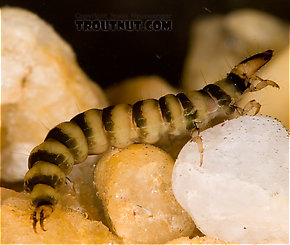 View 10 PicturesThis is the first Rhyacophila larva I've seen with this striking black banded appearance. I caught several larvae of this species in a fast riffle in a mid-sized trout stream.
View 10 PicturesThis is the first Rhyacophila larva I've seen with this striking black banded appearance. I caught several larvae of this species in a fast riffle in a mid-sized trout stream.
 View 10 PicturesThis is the first Rhyacophila larva I've seen with this striking black banded appearance. I caught several larvae of this species in a fast riffle in a mid-sized trout stream.
View 10 PicturesThis is the first Rhyacophila larva I've seen with this striking black banded appearance. I caught several larvae of this species in a fast riffle in a mid-sized trout stream.Collected March 30, 2007 from Fall Creek in New York
Added to Troutnut.com by Troutnut on April 2, 2007
Added to Troutnut.com by Troutnut on April 2, 2007
Top 10 Fly Hatches
Top Gift Shop Designs
Eat mayflies.
Top Insect Specimens
Miscellaneous Sites
Troutnut.com is copyright © 2004-2024 Jason
Neuswanger (email Jason). See my FAQ for information about use of my images.
 privacy policy
privacy policy
